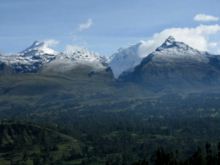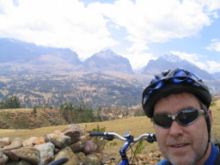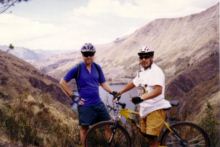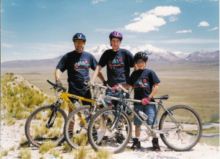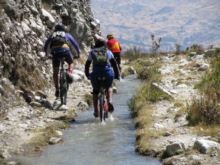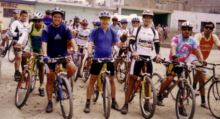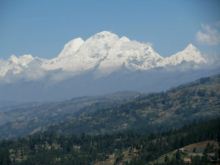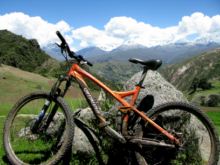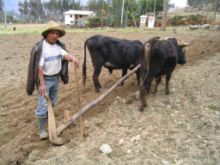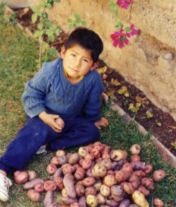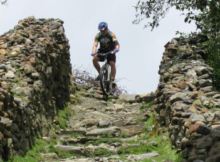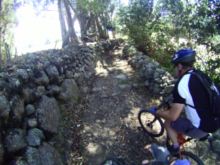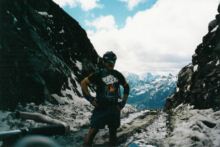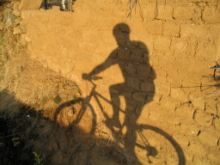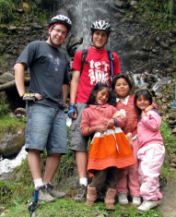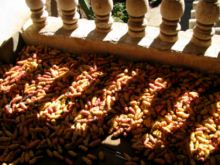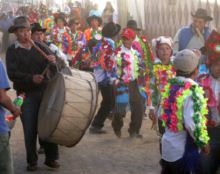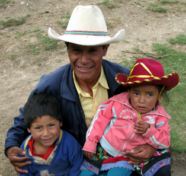EPIC CHAKINAANI *
by Dan Hintz
*chakinaani means ‘singletrack’ in Quechua
And the winner of this year’s “World’s Best-kept Secret” award goes to—deafening silence and mounting suspense as the envelope is ceremoniously opened—Mountain Biking in the Callejón de Huaylas. Wild applause and a standing ovation!!! Cycling out my front door in Huaraz, hmmm, what network of world-class chakinaani (singletrack) today—Cordillera Blanca, Cordillera Negra, cross-country, downhill, or maybe freeride? So many trails, so little time.
Great to have riding buddies. At noon the phone rings. “Hey Daniel, can you break away from writing that Quechua grammar?” One of my favorite questions and so much easier than “What’s the role of contact within language evolution?” Donning jersey and shorts plus a squirt of chainlube on the ole’ Stumpjumper…and we’re off. The only thing better than a full course meal of haka pikanti (spicy guinea pig) and llunka kashki (wheat soup) with papa a la huancaína (potato salad in special sauce) is postponing that scrumptious almuerzo to ride yet another pre-Inca trail on my trusty steed.
Soon we’ve entered the natural, rustic beauty of the hallqa (high Andean countryside). Avoiding the dirt road, we opt instead for donkey trails and goat paths that wend their way through lush pastures and glacier-fed streams. We are, in fact, surrounded by magnificent, towering glaciers. All the while we skirt small fields of akshu (potatoes) in full bloom and young hara (corn) plants stretching skyward to face the tropical sun.
We pause near a freshly planted field to greet Miguel, a local farmer who is resting a fine pair of bulls yoked to the taklla (wooden plow). “Yame:llaku ke:kanki?” he greets us cheerfully in Huaylas Quechua. “Allillachaa, taytay” (“We’re fine, Father.”) I respond. Recognizing the Conchucos Quechua variety, he teases, “Oh, so you’re a Chuki. Careful you don’t fall on this rough Huaylas trail! Come have some delicious tuqush.” (Tuqush or “ripe potato pudding” has a distinctive odor easily detectable within a 100 meter radius. It’s highly nutritious with traces of penicillin.)
The Andes mountains surrounding Huaraz (el. 10,000’+) offer an almost infinite variety of criss-crossing singletrack, ideal for mountain bike enthusiasts of all persuasions. My own preference is cross-country, especially climbing as the main course with downhill for a tasty dessert. Ascents in this maze of trails range from gentle to brutal, with undulating roller-coasters, mesas, canyons, streams, and meadows. Descents offer challenges galore, rocky millennial trails with occasional steep grassy slopes. All routes, even the zigzags and shortcuts of the winding dirt road, are guaranteed to keep adrenal glands in tiptop working condition. Mere words can’t begin to describe the feeling of traversing the Cordillera Negra on a bike, descending rocky steps and terraces fashioned by the ancients, pausing to admire the majestic, yet receding tropical glaciers of the mighty Cordillera Blanca.
I have a dozen favorite trails. Each offers sweeping panoramas of Tolkienesque landscapes coupled with intimate connection to the more immediate stuff of earth—Quechua people, sun-baked adobe, wild and domestic creatures, uqa and ulluku plants, mammoth boulders, cascades and cataracts. A local guide discovered these epic routes and more, endowing them with classic names such as Simple Twist of Fate and Like a Rolling Stone. But we’re always exploring, finding new variations in the web of trails interwoven over the centuries.
The longer I live in this area, the more I’ve come to appreciate the traditional knowledge encoded in the language and daily life of people like Miguel. In spite of (or because of) my formal education, I’ve never learned how to make a plow and yoke, to weave a colorful poncho or shawl, or even to prepare tuqush. But I have learned how the Quechua language works. It’s gratifying to simply share a booklet with a Quechua neighbor. “Oh, my language can be written!” Sadly, external forces worldwide threaten native languages, traditional values, and ways of viewing the world that can enrich our own. Given the opportunity to pass through this amazing territory, let’s keep our senses keenly focused not only on the trail before us, but especially on local people who can teach us so much along the way.
Article and photos copyright Daniel J. Hintz, published in Huaraz Map Guide 2010
